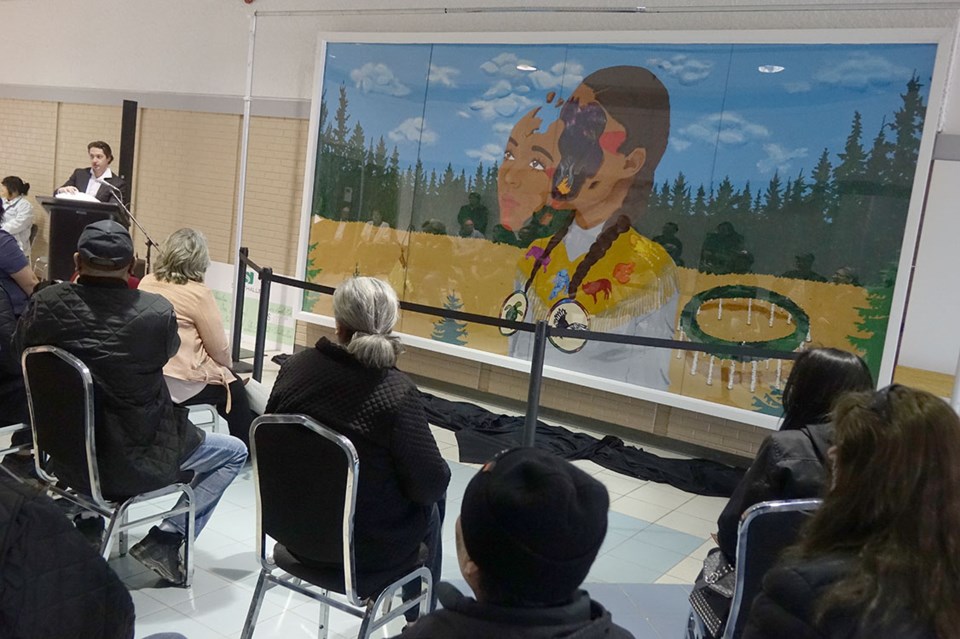At first glance, actions like those taken by Strathallen, the company that owns Thompson’s City Centre Mall, which unveiled a mural by an Indigenous artist on April 17 and previously raised the Nisichawayasihk Cree Nation flag on one of its flagpoles and installed a monument acknowledging that the property is within NCN’s traditional territory, can seem like mere gestures and not substantial progress towards reconciliation between Indigenous Peoples and the greater Canadian population, which has frequently treated the country’s original inhabitants horribly, whether through neglect or outright hostility.
They are, it is true, symbolic, but symbols are important. Indicating that you recognize the history of the land you occupy and the misdeeds that have occurred in the past and continue to happen today gives those who have suffered from those misdeeds an opportunity to be heard and seen, to feel that their suffering has not gone unnoticed.
When it comes to the First Nations that surround Thompson, which make up most of Northern Manitoba’s population, the truth is that the Hub of the North is, in fact, dependent upon their residents if it wishes to thrive. Those residents, in turn, benefit from the existence of Thompson and the businesses and services that are located here. It is a symbiotic relationship that benefits all parties involved.
Mayor Colleen Smook is fond of saying that, although Thompson is a city of 13,000, it also functions as the service centre for a regional population of more than 50,000. Without people from outlying communities travelling to Thompson to shop, to obtain health care, to play in hockey tournaments, to patronize events like Nickel Days, the economy of Thompson would look much different.
That said, symbols are not enough. Residents of Thompson, like residents of communities all throughout Canada, are not doing enough if they merely acknowledge the wrongs done to Indigenous Peoples by past governments and citizens and institutions. Wearing an orange shirt, while appreciated and important, does not undo the damage wrought by the residential school system, or alleviate the ills that affect Canadians today, Indigenous and non-Indigenous alike, many of which are directly related to past actions and policies. Harder work must be done to eliminate discrimination against Indigenous Peoples, which not only includes people behaving in bigoted or racist ways, but also things like discrepancies between how much money per student federally funded schools on reserve receive compared to provincially funded ones elsewhere, or the fact that some First Nations still don’t have running water in all their homes, or must boil the water they have before it is considered safe to drink. Indigenous People are less well-off than other Canadians in many ways, from life expectancy to incarceration rates to high school graduation levels to how likely they are to die or get injured in a residential fire or to have their children end up in the child welfare system. As much progress as has been made over the course of Canada’s history with respect to how the government and the country’s citizens treat Indigenous Peoples, the progress remains painfully slow and equality still seems far off.
None of this is to say that land acknowledgements and symbolic gestures are not important. It is merely recognition that they are not all-important. Reconciliation is not goal or a box to be checked off, something that a single action can accomplish. It is a process, one that requires that biases against Indigenous Peoples in the health care system be addressed and eliminated, that actions be taken to ensure that all Canadians are equally prepared to take part in and contribute to the country’s economy. As an old saying goes, a rising tide lifts all boats. However, if some of those boats are leaky and half-submerged, lifting them the same amount as far more seaworthy boats does not achieve equity. It merely perpetuates existing inequality. But as another saying goes, don’t let the perfect be the enemy of the good. The fact that true and complete reconciliation is a long way off doesn’t mean that no attempts should be made until it is achieved. Improving the lives of Indigenous Peoples will have benefits for all Canadians and, in a region like Northern Manitoba, where a large majority of residents identify as Indigenous, the benefits could be even greater.



